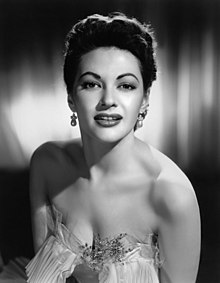Yvonne de Carlo
| Yvonne De Carlo | |
|---|---|

De Carlo, c. 1955
|
|
| Born |
Margaret Yvonne Middleton September 1, 1922 West Point Grey (present-day Vancouver), British Columbia, Canada |
| Died | January 8, 2007 (aged 84) Los Angeles, California, United States |
| Cause of death | Heart failure |
| Education | Lord Roberts School King Edward High School |
| Occupation | Actress, dancer, singer |
| Years active | 1941–1995 |
| Notable work | Sephora from Cecil B. DeMille's The Ten Commandments (1956) |
| Political party | Republican |
| Spouse(s) | Robert Drew "Bob" Morgan (m. 1955; div. 1973) |
| Children | Bruce Morgan (b. 1956) Michael Morgan (1957–1997) |
| Parent(s) | William Middleton (father) Marie De Carlo (mother) |
| Musical career | |
| Genres | |
| Instruments | Vocals |
| Labels | |
Yvonne De Carlo (born Margaret Yvonne Middleton; September 1, 1922 – January 8, 2007) was a Canadian-American actress, dancer, and singer. A beautiful brunette with blue-gray eyes, she became an internationally famous Hollywood film star in the 1940s and 1950s, made several recordings, and later acted on television and stage.
Born in Vancouver, British Columbia, De Carlo was raised in the home of her Presbyterian maternal grandparents. Her mother enrolled her in a local dance school when she was three. By the early 1940s, she and her mother had moved to Hollywood, where De Carlo participated in beauty contests and worked as a dancer in nightclubs. In 1942, she signed a three-year contract with Paramount Pictures, where she was given uncredited bit parts in important films and was intended to replace Dorothy Lamour. Paramount loaned her out to Republic Pictures for her first credited role in a feature film, Wah-Tah in the independent production Deerslayer (1943).
She obtained her breakthrough role in Salome, Where She Danced (1945), a Universal-International release produced by Walter Wanger, who described her as "the most beautiful girl in the world." The film's publicity and success turned her into a star, and she signed a five-year contract with Universal. From then on, Universal starred her in B movies, usually westerns, adventures, or musicals in Technicolor. Cameramen voted her "Queen of Technicolor" three years in a row. Tired of being typecast as exotic women, her first efforts to become a serious dramatic actress came with her performances in two film noirs, Brute Force (1947) and Criss Cross (1949).
She received further recognition as an actress when she starred in the British comedies Hotel Sahara (1951) and The Captain's Paradise (1953). Her film career reached its peak when eminent producer-director Cecil B. DeMille cast her as Moses' Midianite wife, Sephora, her most prominent role, in his biblical epic The Ten Commandments (1956), which was immensely successful at the box office.
...
Wikipedia
